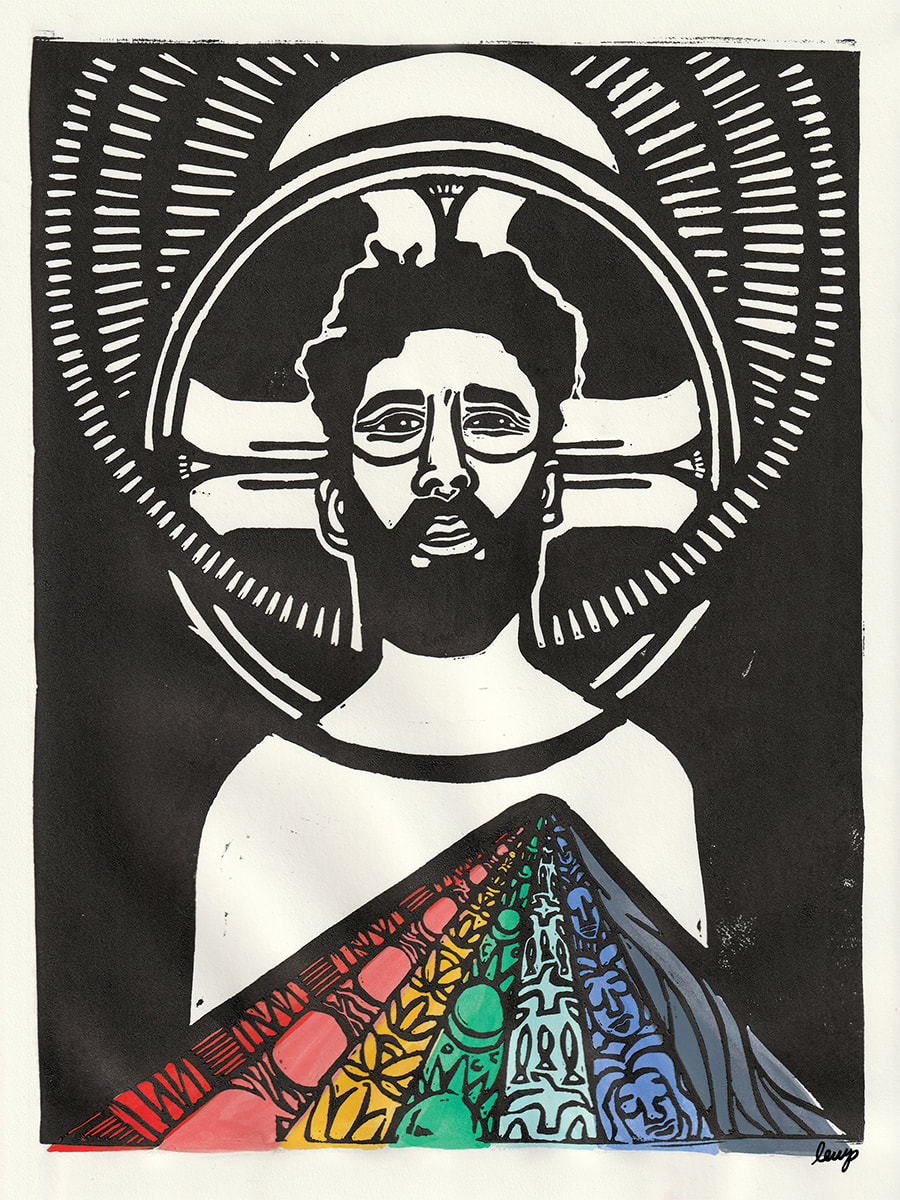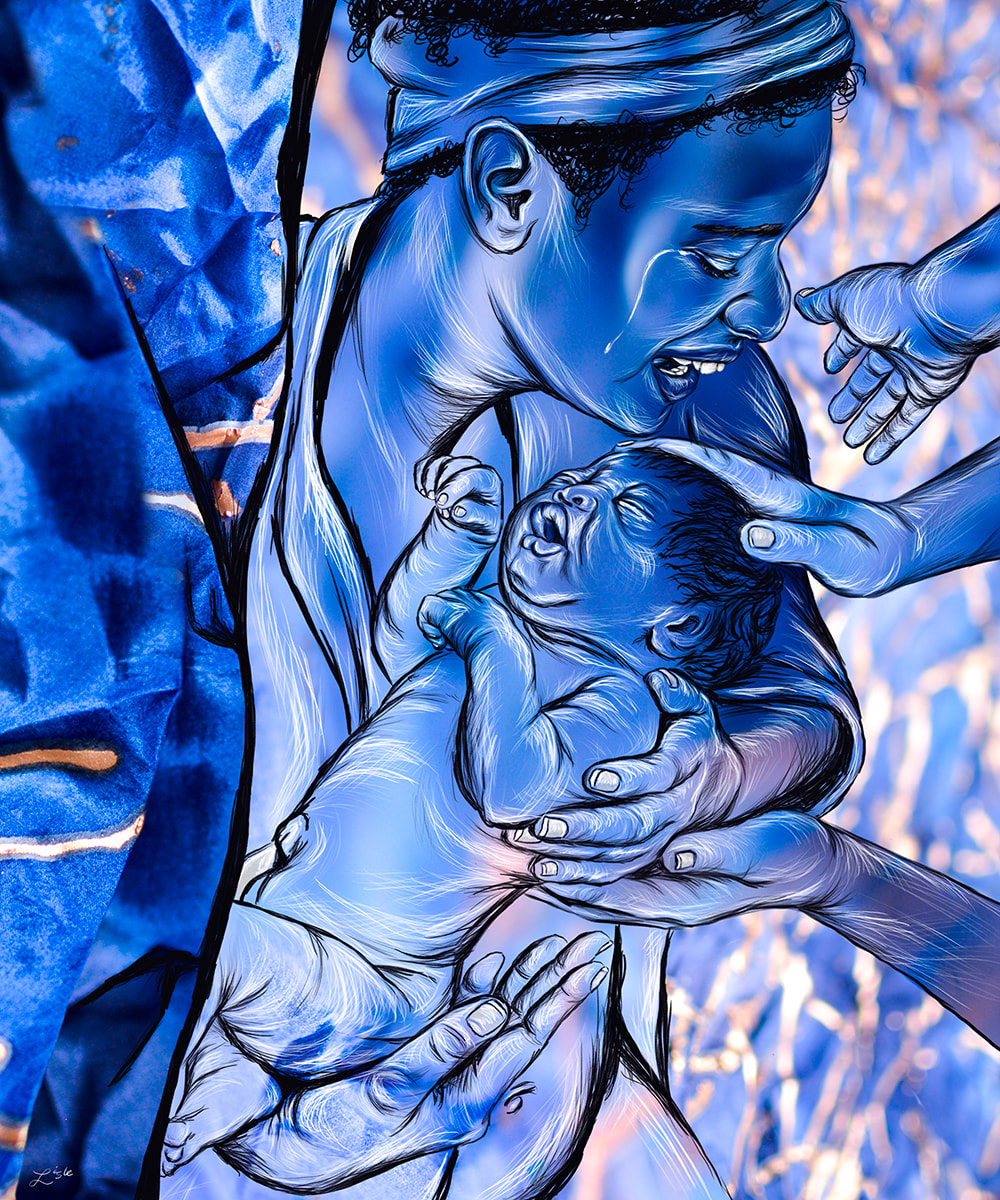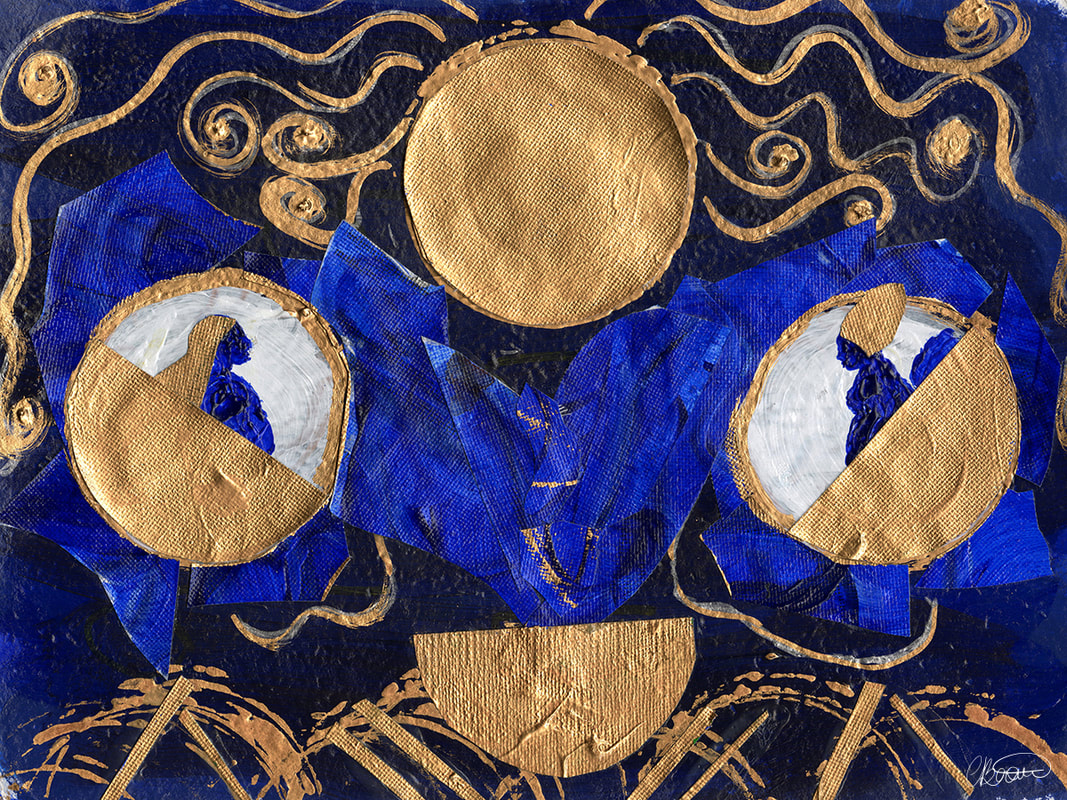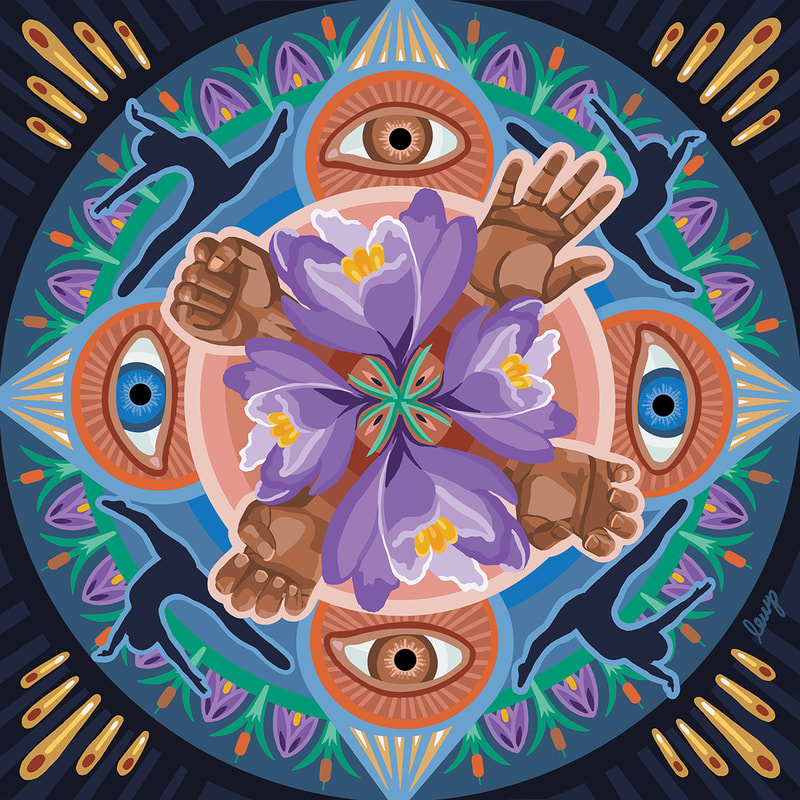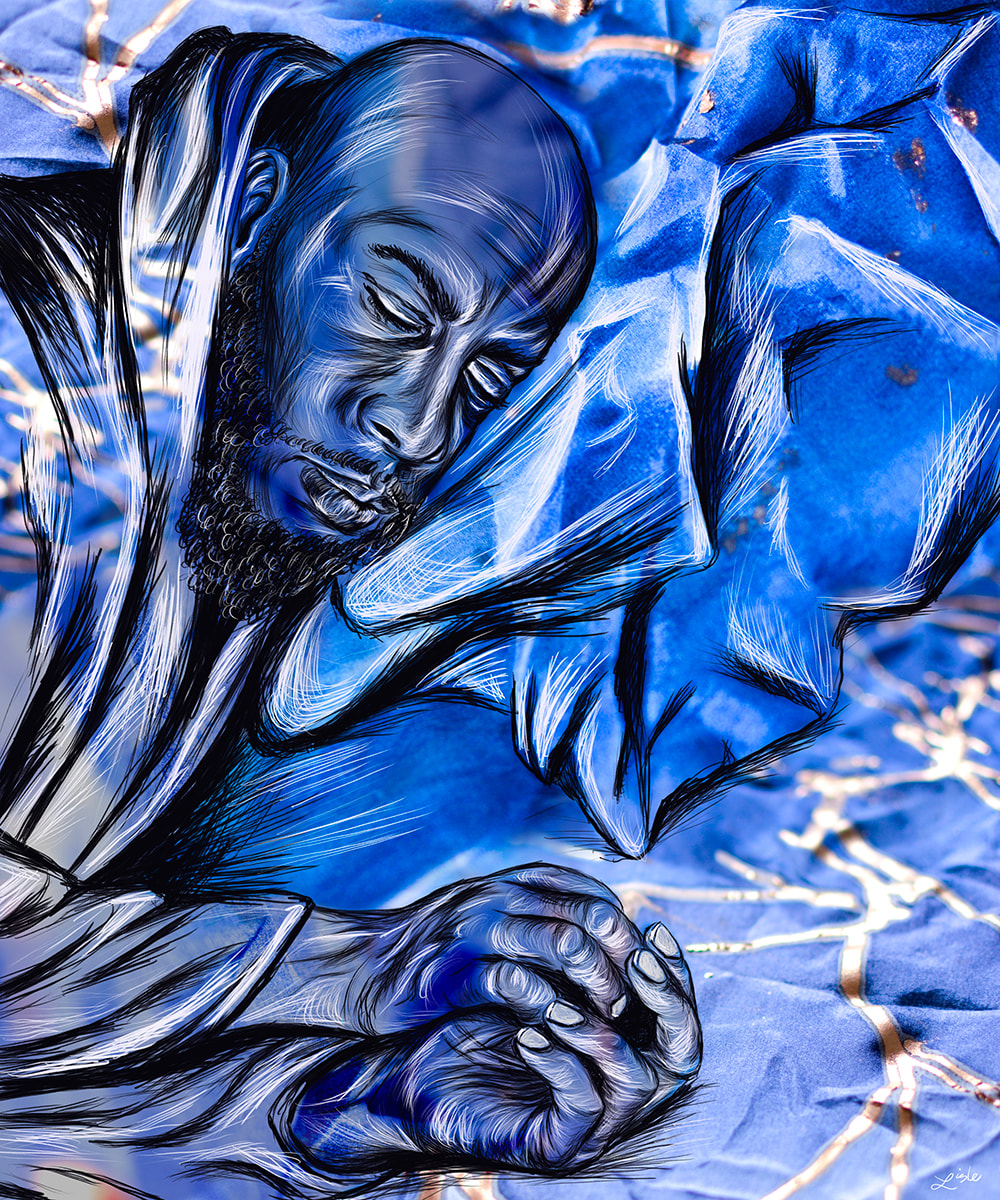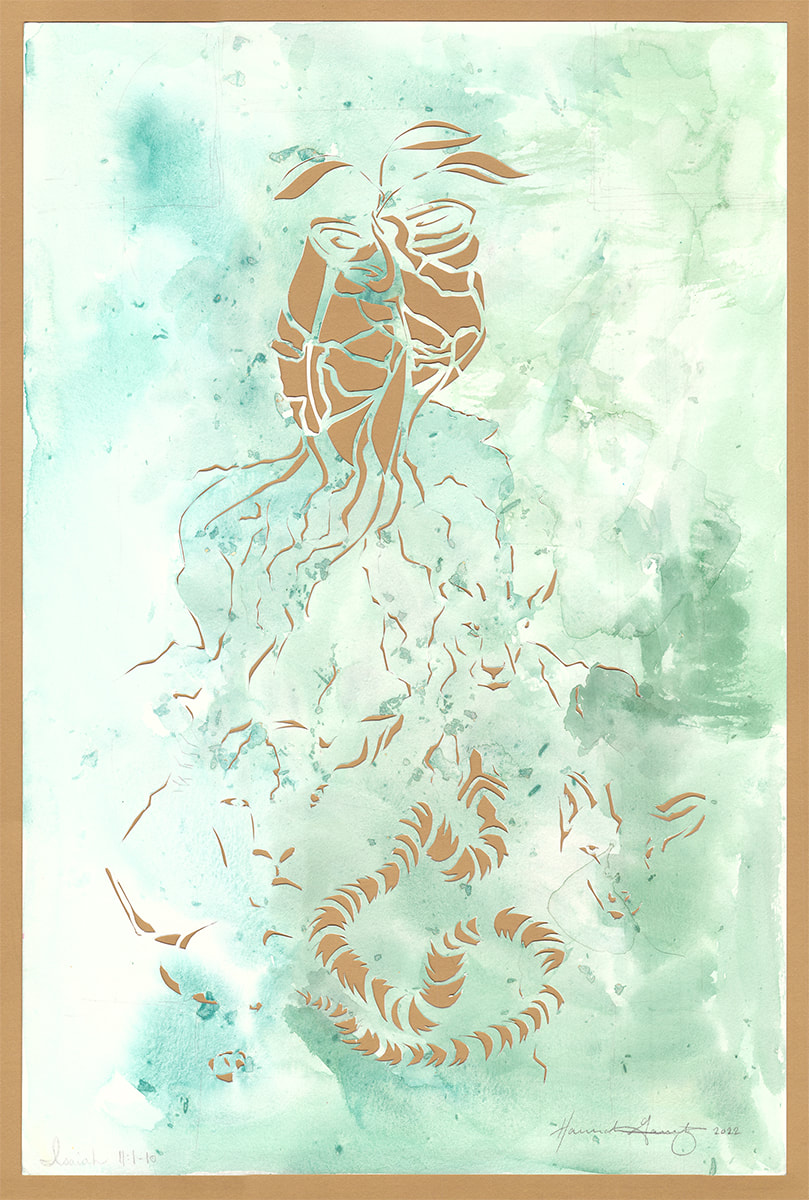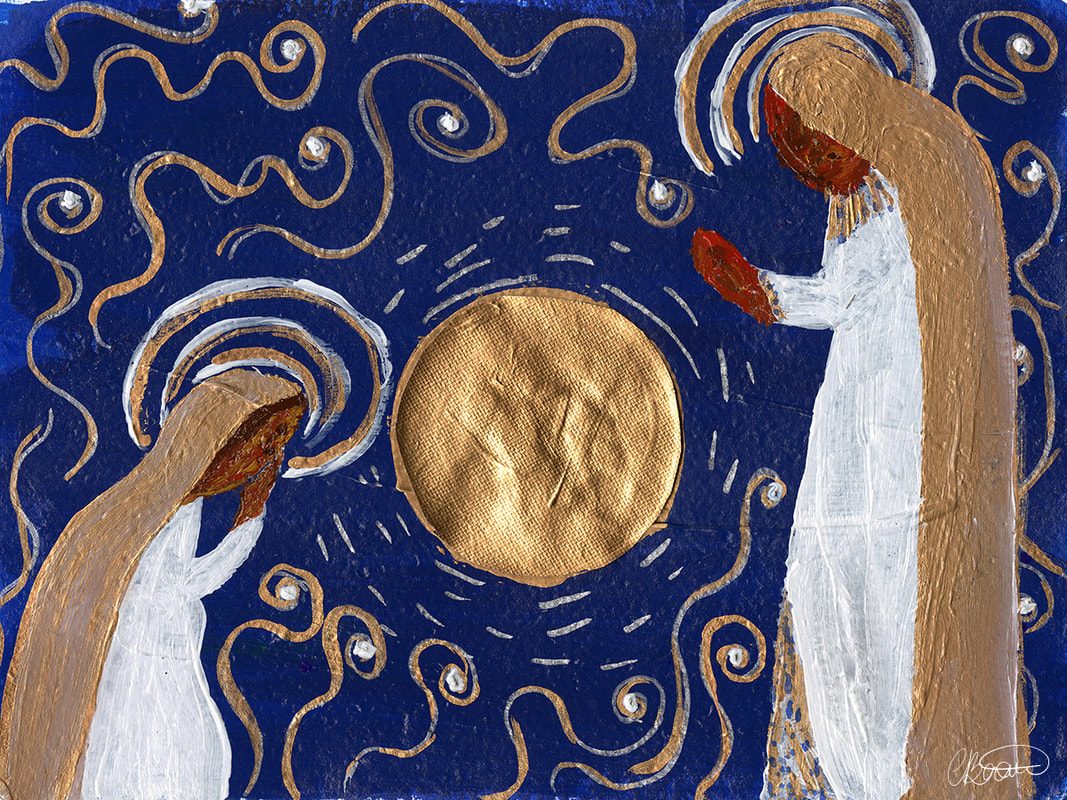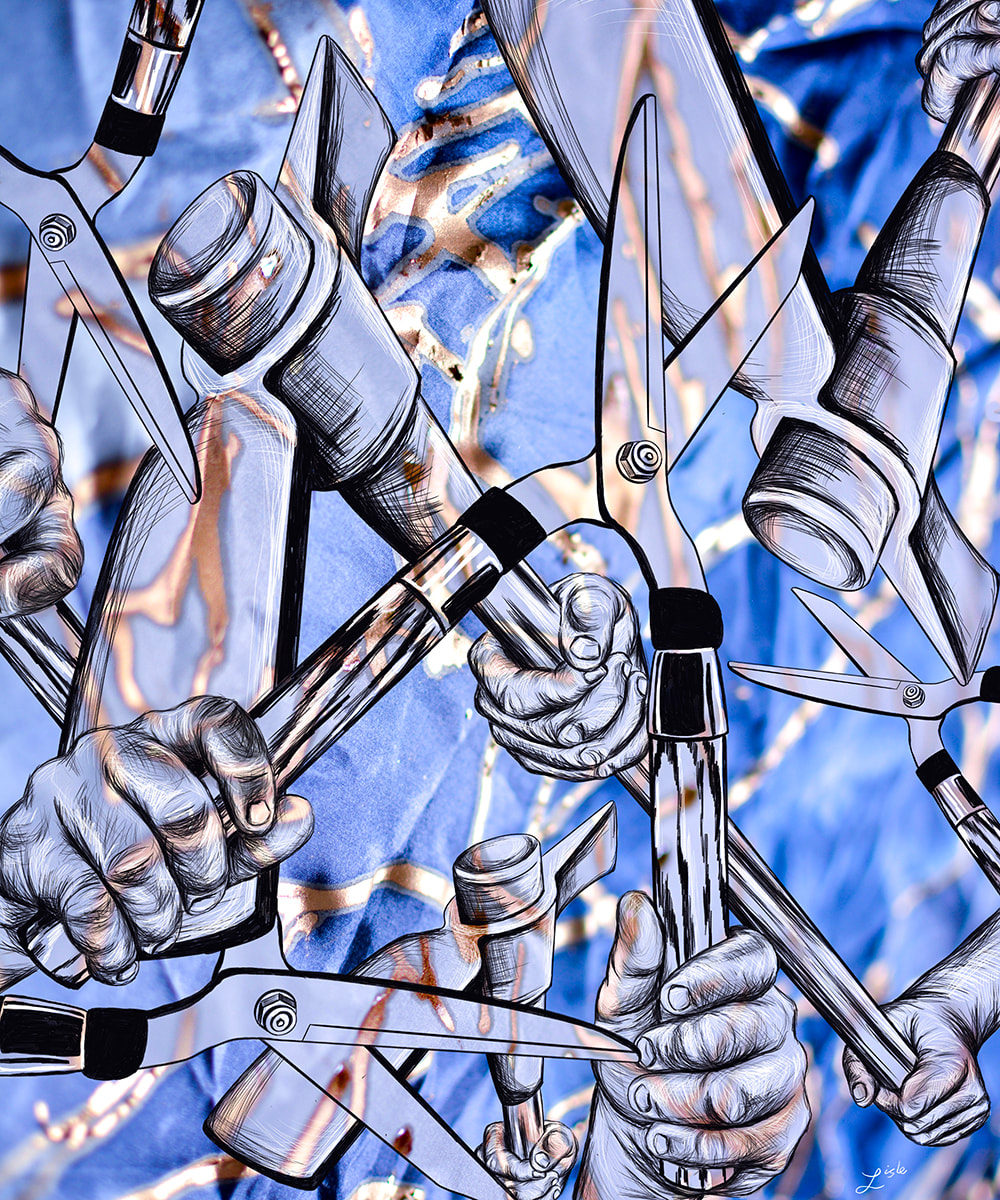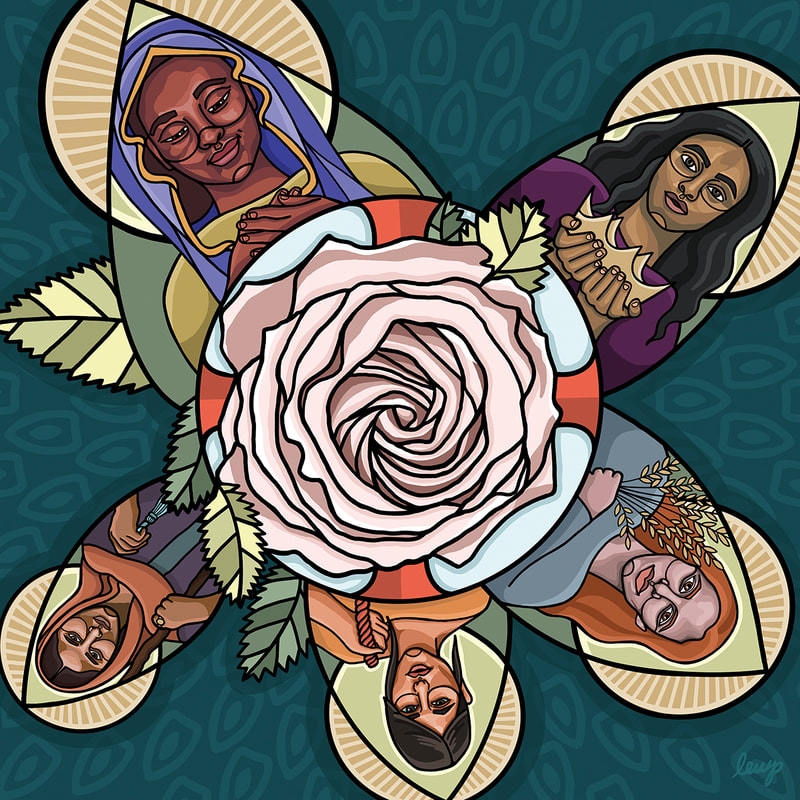Check back each week for updates.
Christmas Day
God dwells with us
|
Through Him, All Things| Lauren Wright Pittman |
A Sanctified Art LLC | sanctifiedart.org Block print with oil-based ink over gouache painting |
Read John 1:1-14
|
SABBATH IN
|
As a Sabbath activity, follow this family recipe or prepare another favorite dish.
|
MIYEOK-GUK
A family recipe shared by Christine J. Hong
Miyeok-guk is a traditional postpartum meal for new mothers and a traditional Korean birthday meal. Korean people make and eat Miyeok-guk to celebrate growing a year older and to honor the labor of their mothers who brought them into the world.
INGREDIENTS______________________________________________________________________________________________________________
• 1 ounce of dried miyeok/seaweed (you can find this in the dried goods section at a Korean grocery store like H Mart)
• 1 pound of beef brisket sliced into small pieces (you can substitute any shellfish)
• 1 packet of bone broth or anchovy and dried kelp broth (you can find both kinds of broth ready-made and packaged at a Korean grocery store—bonus, they are shelf stable—or you can make your own)
• 1-2 teaspoons of toasted sesame oil, to taste
• 1-2 tablespoons of soup soy sauce or light soy sauce, to taste (you can substitute fish sauce)
• 4 minced cloves of garlic
INSTRUCTIONS_____________________________________________________________________________________________________________
Soak your miyeok/seaweed in cold water. It will rehydrate. Once rehydrated, drain, and cut it up into small bite-sized pieces. Prepare your brisket by cutting it up into small pieces. To a pot, add 6 cups of water and the miyeok. Cover and boil on high for about 10 minutes. Add in the brisket and boil at medium heat for 35-40 minutes. Stir occasionally. The beef will slowly become tender. Stir in your garlic, bone broth, and soup soy sauce and boil for 10 more minutes. Stir in the sesame oil. For a full meal, serve alongside or over hot rice with kimchi on the side. Serves 3-4 people.
A family recipe shared by Christine J. Hong
Miyeok-guk is a traditional postpartum meal for new mothers and a traditional Korean birthday meal. Korean people make and eat Miyeok-guk to celebrate growing a year older and to honor the labor of their mothers who brought them into the world.
INGREDIENTS______________________________________________________________________________________________________________
• 1 ounce of dried miyeok/seaweed (you can find this in the dried goods section at a Korean grocery store like H Mart)
• 1 pound of beef brisket sliced into small pieces (you can substitute any shellfish)
• 1 packet of bone broth or anchovy and dried kelp broth (you can find both kinds of broth ready-made and packaged at a Korean grocery store—bonus, they are shelf stable—or you can make your own)
• 1-2 teaspoons of toasted sesame oil, to taste
• 1-2 tablespoons of soup soy sauce or light soy sauce, to taste (you can substitute fish sauce)
• 4 minced cloves of garlic
INSTRUCTIONS_____________________________________________________________________________________________________________
Soak your miyeok/seaweed in cold water. It will rehydrate. Once rehydrated, drain, and cut it up into small bite-sized pieces. Prepare your brisket by cutting it up into small pieces. To a pot, add 6 cups of water and the miyeok. Cover and boil on high for about 10 minutes. Add in the brisket and boil at medium heat for 35-40 minutes. Stir occasionally. The beef will slowly become tender. Stir in your garlic, bone broth, and soup soy sauce and boil for 10 more minutes. Stir in the sesame oil. For a full meal, serve alongside or over hot rice with kimchi on the side. Serves 3-4 people.
SANCTIFIED ART FROM GENERATION TO GENERATION ADVENT DEVOTIONAL | GOD DWELLS WITH US |
Christmas Eve
We tell this story
|
How God Shows Up| Lisle Gwynn Garrity |
A Sanctified Art LLC | sanctifiedart.org Silk painting with digital drawing and collage |
Read Luke 2:1-20
|
SANCTIFIED ART FROM GENERATION TO GENERATION ADVENT DEVOTIONAL | WE TELL THIS STORY |
Fourth Week of Advent
We are God in each other
|
The Golden Cradle| Carmelle Beaugelin |
A Sanctified Art LLC | sanctifiedart.org Acrylic, gilding paint, canvas collage on handmade reclaimed paper |
Read Luke 1:39-58
|
SANCTIFIED ART FROM GENERATION TO GENERATION ADVENT DEVOTIONAL | WE SEE GOD IN EACH OTHER|
Third Week of Advent
We can choose a better way
|
Wilderness Blossom | Lauren Wright Pittman |
A Sanctified Art LLC | sanctifiedart.org Digital painting |
Read Isaiah 35:1-10
|
|
The Courageous Choice | Lisle Gwynn Garrity |
A Sanctified Art LLC | sanctifiedart.org Silk painting with digital drawing and collage |
Read Matthew 1:18-25
|
SABBATH IN
|
As a Sabbath activity, follow this family recipe or prepare another favorite dish.
|
PEANUT'S PECAN PIE (ADAPTED FOR POPPA)
A family recipe shared by Lauren Wright Pittman
Peanut was my Poppa’s (my maternal grandfather) little sister who was born in 1944. Peanut learned to cook early on because she wasn’t able to work in the fields with the rest of her family. Her pecan pie was my Poppa’s absolute favorite. Her pie was a seasonal treat because she had to wait for the pecan trees to drop the nuts, and she cracked them each by hand. It was hard work, so she tried to make it easier in some other ways. She adapted a recipe to use a whole bottle of Karo syrup so she could use up the whole bottle and have it yield two pies. Peanut knew this was also one of my mom’s favorite recipes, so when my mom got married in 1984, Peanut gave her the recipe. As my Poppa grew older, he lost his teeth and wasn’t able to enjoy all the foods he used to. My mom decided to start chopping up the pecans almost to dust so he could taste his favorite pie once again. I lost my Poppa this year. At his celebration of life, we shared his favorite pie and our gratitude for his life with hundreds of his family and friends. I will cherish this recipe for the rest of my life, and will certainly pass it on.
A family recipe shared by Lauren Wright Pittman
Peanut was my Poppa’s (my maternal grandfather) little sister who was born in 1944. Peanut learned to cook early on because she wasn’t able to work in the fields with the rest of her family. Her pecan pie was my Poppa’s absolute favorite. Her pie was a seasonal treat because she had to wait for the pecan trees to drop the nuts, and she cracked them each by hand. It was hard work, so she tried to make it easier in some other ways. She adapted a recipe to use a whole bottle of Karo syrup so she could use up the whole bottle and have it yield two pies. Peanut knew this was also one of my mom’s favorite recipes, so when my mom got married in 1984, Peanut gave her the recipe. As my Poppa grew older, he lost his teeth and wasn’t able to enjoy all the foods he used to. My mom decided to start chopping up the pecans almost to dust so he could taste his favorite pie once again. I lost my Poppa this year. At his celebration of life, we shared his favorite pie and our gratitude for his life with hundreds of his family and friends. I will cherish this recipe for the rest of my life, and will certainly pass it on.
|
INGREDIENTS
• 6 eggs • 2 cups of pecans • 1 bottle dark Karo syrup |
• 4 tablespoons of butter melted, or a 1/2 stick • 1 cup of sugar • 2 pie shells |
INSTRUCTIONS
Mix the ingredients well and pour into the pie shells (be careful not to mix hot butter with the eggs; let it cool first). The recipe makes 2 deep dish pies or 3 regular pies. Bake at 350 degrees for 45 minutes. If using a deep dish, bake for 65 mins.
Mix the ingredients well and pour into the pie shells (be careful not to mix hot butter with the eggs; let it cool first). The recipe makes 2 deep dish pies or 3 regular pies. Bake at 350 degrees for 45 minutes. If using a deep dish, bake for 65 mins.
SANCTIFIED ART FROM GENERATION TO GENERATION ADVENT DEVOTIONAL | WE CAN SCHOOSE A BETTER WAY|
Second Week of Advent
God meets us in our fear
Read Isaiah 11:1-10
|
|
Mary's Golden Annunciation | Carmelle Beaugelin |
A Sanctified Art LLC | sanctifiedart.org Acrylic, gilding paint, canvas collage on handmade reclaimed paper |
Read Luke 1:26-38
|
SABBATH IN
|
As a Sabbath activity, follow this family recipe or prepare another favorite dish.
|
DECORATED CHRISTMAS COOKIES
A family recipe shared by Lisle Gwynn Garrity
As a child, Christmastime always promised us a tradition that was an otherwise forbidden activity: the chance to play with our food. My grandmother’s kitchen table became an art studio splattered with flour and sprinkles when, each year, she retrieved the metal tin filled with Christmas-themed cookie cutters, and we spent the afternoon crafting edible Christmas treats. To my knowledge, we never made these cookies from scratch because my grandmother was admittedly not much of a cook, and because pre-made convenience allowed us to devote ourselves to the art of cookie sprinkles. We would spend hours rolling the dough, clapping our hands into flour clouds, and discovering how many red and green sugar crystals could fit on reindeer-shaped patties. And so, for this Sabbath Saturday recipe, I give you permission to focus less on baking and more on playing. I hope you’ll buy pre-made sugar cookie dough, get your kitchen messy, and decorate Christmas cookies with little humans leading the way.
A family recipe shared by Lisle Gwynn Garrity
As a child, Christmastime always promised us a tradition that was an otherwise forbidden activity: the chance to play with our food. My grandmother’s kitchen table became an art studio splattered with flour and sprinkles when, each year, she retrieved the metal tin filled with Christmas-themed cookie cutters, and we spent the afternoon crafting edible Christmas treats. To my knowledge, we never made these cookies from scratch because my grandmother was admittedly not much of a cook, and because pre-made convenience allowed us to devote ourselves to the art of cookie sprinkles. We would spend hours rolling the dough, clapping our hands into flour clouds, and discovering how many red and green sugar crystals could fit on reindeer-shaped patties. And so, for this Sabbath Saturday recipe, I give you permission to focus less on baking and more on playing. I hope you’ll buy pre-made sugar cookie dough, get your kitchen messy, and decorate Christmas cookies with little humans leading the way.
INGREDIENTS
• Store-bought, pre-made sugar cookie dough (or bake from scratch if the word “pre-made” makes you wince)
• Sprinkles—as many kinds and colors as possible
• Store-bought icing
• Store-bought, pre-made sugar cookie dough (or bake from scratch if the word “pre-made” makes you wince)
• Sprinkles—as many kinds and colors as possible
• Store-bought icing
INSTRUCTIONS
With a rolling pin, flatten the cookie dough in between handfuls of flour. Use cookie cutters to cut the dough into fun shapes—or use a knife to freehand Christmas-themed creations. Sprinkle abundantly. Bake until your kitchen swells with sweetness.
With a rolling pin, flatten the cookie dough in between handfuls of flour. Use cookie cutters to cut the dough into fun shapes—or use a knife to freehand Christmas-themed creations. Sprinkle abundantly. Bake until your kitchen swells with sweetness.
SANCTIFIED ART FROM GENERATION TO GENERATION ADVENT DEVOTIONAL | GOD MEETS US IN OUR FEAR |
First Week of Advent
There's room for every story
|
War No More | Lisle Gwynn Garrity |
A Sanctified Art LLC | sanctifiedart.org Silk painting with digital drawing and collage |
Read Isaiah 2:1-5
|
|
Genealogy of Christ | Lauren Wright Pittman | A Sanctified Art LLC | sanctifiedart.org
Digital Painting |
Read Matthew 1:1-17
|
SABBATH IN
|
As a Sabbath activity, follow this family recipe or prepare another favorite dish.
|
NANA'S VINAIGRETTE
A family recipe shared by Hannah Garrity
There are many versions of this dressing, including the simple olive oil and salt version with which Nana (my grandmother) dressed up our salads when she and I visited France in the autumn of 1999. Her first time there, in the 1950's when my mother was young, became the inspiration for many of the recipes that we then inherited. Perhaps this dressing is such one. My memories of our salad dressing span decades and are drenched in joy. I was finally old enough to sit with the older cousins and adults. With thirty people surrounding the table, the salad was always already dressed. It was my favorite part of the meal. The dressing would slide under the rice on my plate, creating a unique delicacy that I would recreate in my college dining hall as comfort food years later. Sounds of laughter and repeated stories, feelings of love and warmth would flood back at the first taste. No one in my family makes the dressing just like anyone else. Every time it is a little bit different for everyone. So, as a snapshot of a moment in a long and fluid span of time, here’s the recipe Nana made, as I remember it, on that distant day when I thought to take note.
A family recipe shared by Hannah Garrity
There are many versions of this dressing, including the simple olive oil and salt version with which Nana (my grandmother) dressed up our salads when she and I visited France in the autumn of 1999. Her first time there, in the 1950's when my mother was young, became the inspiration for many of the recipes that we then inherited. Perhaps this dressing is such one. My memories of our salad dressing span decades and are drenched in joy. I was finally old enough to sit with the older cousins and adults. With thirty people surrounding the table, the salad was always already dressed. It was my favorite part of the meal. The dressing would slide under the rice on my plate, creating a unique delicacy that I would recreate in my college dining hall as comfort food years later. Sounds of laughter and repeated stories, feelings of love and warmth would flood back at the first taste. No one in my family makes the dressing just like anyone else. Every time it is a little bit different for everyone. So, as a snapshot of a moment in a long and fluid span of time, here’s the recipe Nana made, as I remember it, on that distant day when I thought to take note.
|
INGREDIENTS
• ½ cup olive oil • ⅓ cup balsamic vinegar • 2 tablespoons dijon mustard • 1 teaspoon basil • ½ teaspoon of salt • A pinch of pepper |
INSTRUCTIONS
Shake or stir the dressing. Dip a piece of lettuce in it. Taste it. Add salt if needed. Dress and toss the whole salad. Serve with any meal. Enjoy. |
SANCTIFIED ART FROM GENERATION TO GENERATION ADVENT DEVOTIONAL | THERE'S ROOM FOR EVERY STORY |
A Sanctified Art LLC is a collective of artists in ministry who create resources for worshiping communities. The Sanctified Art team works collaboratively to bring scripture and theological themes to life through film, visual art, curriculum, coloring pages, liturgy, graphic designs, and more. Their mission is to empower churches with resources to inspire creativity in worship and beyond. Drive by the connective and prophetic power of art, they believe that art helps us connect our hearts with our hands, our faith with our lives, and our mess with our God.
Learn more about their work at sanctifiedart.org.
Learn more about their work at sanctifiedart.org.

